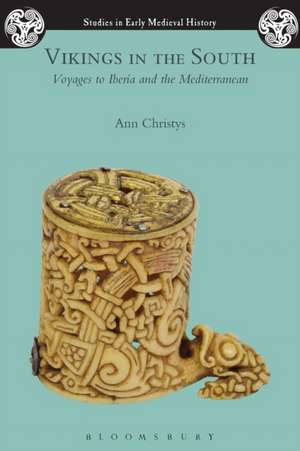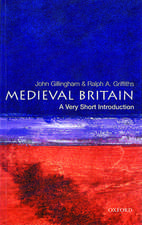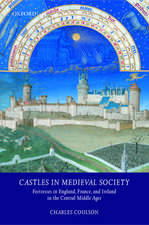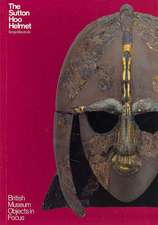Vikings in the South: Voyages to Iberia and the Mediterranean: Studies in Early Medieval History
Autor Dr Ann Christysen Limba Engleză Paperback – 26 aug 2015
| Toate formatele și edițiile | Preț | Express |
|---|---|---|
| Paperback (1) | 235.00 lei 6-8 săpt. | |
| Bloomsbury Publishing – 26 aug 2015 | 235.00 lei 6-8 săpt. | |
| Hardback (1) | 769.71 lei 6-8 săpt. | |
| Bloomsbury Publishing – 26 aug 2015 | 769.71 lei 6-8 săpt. |
Preț: 235.00 lei
Preț vechi: 271.35 lei
-13% Nou
Puncte Express: 353
Preț estimativ în valută:
44.97€ • 46.39$ • 37.53£
44.97€ • 46.39$ • 37.53£
Carte tipărită la comandă
Livrare economică 26 martie-09 aprilie
Preluare comenzi: 021 569.72.76
Specificații
ISBN-13: 9781474213752
ISBN-10: 1474213758
Pagini: 152
Ilustrații: 10 bw illus
Dimensiuni: 156 x 234 x 10 mm
Greutate: 0.23 kg
Editura: Bloomsbury Publishing
Colecția Bloomsbury Academic
Seria Studies in Early Medieval History
Locul publicării:London, United Kingdom
ISBN-10: 1474213758
Pagini: 152
Ilustrații: 10 bw illus
Dimensiuni: 156 x 234 x 10 mm
Greutate: 0.23 kg
Editura: Bloomsbury Publishing
Colecția Bloomsbury Academic
Seria Studies in Early Medieval History
Locul publicării:London, United Kingdom
Caracteristici
Brings together evidence from Arabic and Latin to make sense of the historical events, sometimes erroneously regarded as fanciful
Notă biografică
Ann Christys is an independent scholar. She completed her PhD, published as Christians in al-Andalus 711-1000 (2002), at Leeds and has published on the historiography of al-Andalus and on Christian-Muslim relations.
Cuprins
List of IllustrationsPreface and AcknowledgmentsChapter 1. Introduction: Don Teudo Rico Defeats a Viking raidChapter 2. From the Encircling OceanChapter 3. So the Story GoesChapter 4. A Mediterranean AdventureChapter 5. Waiting for the BarbariansChapter 6. The Wars of Santiago and Cordoba against VikingsChapter 7. Conclusion: from Charter to History to SagaAppendix 1: Glossary of Histories and HistoriansAppendix 2: TimelineBibliographyIndex
Recenzii
One of the great strengths of this book is that, from start to finish, all of the written sources - whether in Arabic, Latin, Old Norse or Romance - are treated with the utmost degree of caution ... Ann Christys treads a cautious path and we should all be grateful to her for having, with infinite patience and considerable skill, built such a secure and durable bridge to the various fields of operations of those Viking sun-seekers.
Christys has a profound knowledge of both Arabic and Latin sources on the Viking voyages to the south ... She discusses every work of any importance, evaluates them critically and shows that only few are indeed reliable ... This book is invaluable for every student and researcher of Viking Age history.
The contribution of this volume is more than filling in a 'blank' spot in the wider modern histories of Vikings ...The books offers approaches to understanding how Islamic and Christian writers thought about themselves and their attackers and in particular the historiographic analysis is a thorough scrutiny of themes, differences and sources for the history of Vikings in the south.
[A]n important work that fills a gap in English-language scholarship ... Christys is to be commended for opening up this ... material for further study.
Ann Christys's concise and well-written book fills a real need; she has read carefully all relevant sources, in Arabic, Old Norse and Latin, concerning possible Viking visits to the coasts of the Iberian Peninsula in the ninth and tenth centuries, stripped away many romanticized details that have attached to the accounts over the years, and come up with a sober assessment: that there were indeed occasional such attacks, but the shock and fear which the Vikings generated in coastal areas of the Iberian Peninsula were lasting, and greater than the actual threat.
Ann Christys has made what might at first seem a small contribution to Viking history recognisable as not just significant but, in its field, definitive. Her knowledge of Arabic as well as Latin (and relevant modern languages) gives her work the edge on previous discussions of Vikings in the South. In methodological terms, her sifting-out of the grist in ninth-century sources adds something new to Viking historiography, while her critical analysis of later myths and their contexts is exemplary, illuminating, and enjoyable.
The Vikings in Iberia are remarkably elusive - our picture of them shaped by genres as diverse as Ptolemaic geography, Scandinavian saga and crusading narrative, affected by the recurring need of foils for heroes - saintly or secular. Dr Christys uses her formidable linguistic range and scholarly judgment to track them. On the way we lose Viking cheese, but gain Viking mice! The overall result is a major addition to our knowledge not only of Vikings, but of early medieval Iberia, and especially of Iberian historiography, both Christian and Muslim.
This is the first study of the Vikings in Iberia to be based on modern methodological principles and a profound knowledge of Muslim historiography. It puts this field of study on an entirely new footing and amounts to a true spring cleaning.
This account of Scandinavian activity in Iberia and around the Mediterranean from the ninth to the eleventh centuries is based mainly on a thorough and very welcome analysis of the problems posed by medieval Muslim and Christian texts. It will be an invaluable guide to future students of the Vikings.
Christys has a profound knowledge of both Arabic and Latin sources on the Viking voyages to the south ... She discusses every work of any importance, evaluates them critically and shows that only few are indeed reliable ... This book is invaluable for every student and researcher of Viking Age history.
The contribution of this volume is more than filling in a 'blank' spot in the wider modern histories of Vikings ...The books offers approaches to understanding how Islamic and Christian writers thought about themselves and their attackers and in particular the historiographic analysis is a thorough scrutiny of themes, differences and sources for the history of Vikings in the south.
[A]n important work that fills a gap in English-language scholarship ... Christys is to be commended for opening up this ... material for further study.
Ann Christys's concise and well-written book fills a real need; she has read carefully all relevant sources, in Arabic, Old Norse and Latin, concerning possible Viking visits to the coasts of the Iberian Peninsula in the ninth and tenth centuries, stripped away many romanticized details that have attached to the accounts over the years, and come up with a sober assessment: that there were indeed occasional such attacks, but the shock and fear which the Vikings generated in coastal areas of the Iberian Peninsula were lasting, and greater than the actual threat.
Ann Christys has made what might at first seem a small contribution to Viking history recognisable as not just significant but, in its field, definitive. Her knowledge of Arabic as well as Latin (and relevant modern languages) gives her work the edge on previous discussions of Vikings in the South. In methodological terms, her sifting-out of the grist in ninth-century sources adds something new to Viking historiography, while her critical analysis of later myths and their contexts is exemplary, illuminating, and enjoyable.
The Vikings in Iberia are remarkably elusive - our picture of them shaped by genres as diverse as Ptolemaic geography, Scandinavian saga and crusading narrative, affected by the recurring need of foils for heroes - saintly or secular. Dr Christys uses her formidable linguistic range and scholarly judgment to track them. On the way we lose Viking cheese, but gain Viking mice! The overall result is a major addition to our knowledge not only of Vikings, but of early medieval Iberia, and especially of Iberian historiography, both Christian and Muslim.
This is the first study of the Vikings in Iberia to be based on modern methodological principles and a profound knowledge of Muslim historiography. It puts this field of study on an entirely new footing and amounts to a true spring cleaning.
This account of Scandinavian activity in Iberia and around the Mediterranean from the ninth to the eleventh centuries is based mainly on a thorough and very welcome analysis of the problems posed by medieval Muslim and Christian texts. It will be an invaluable guide to future students of the Vikings.


























